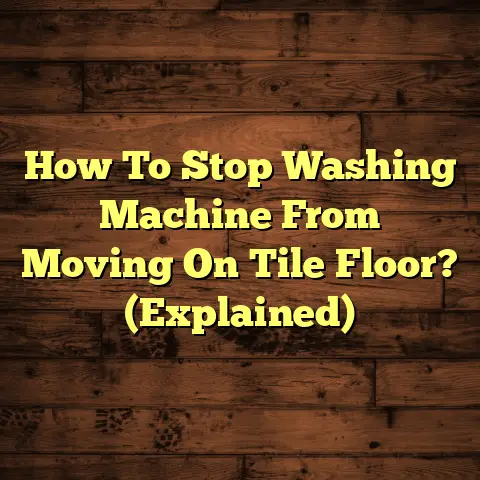Waxing Wood Floors: Step-by-Step (5 Minute Shine!)
Wood floors are seriously having a moment, right?
Everywhere you look, from design mags to your neighbor’s Instagram, it’s all about that natural, warm, and timeless vibe.
And let’s be honest, wood floors aren’t just pretty faces. They’re durable, add character to any room, and can even boost your home’s value.
But here’s the thing: keeping them looking their best can feel like a chore. That’s where waxing comes in.
Yep, waxing! It’s making a comeback as a super easy DIY way to keep your wood floors gleaming.
And guess what? You can get that “wow” factor in practically no time at all – think “5 Minute Shine!”
I’m talking protection from everyday wear and tear, easy application, and results you can see instantly.
Ready to ditch the dullness and bring back the luster? Let’s dive in!
Section 1: Understanding Wood Flooring
Okay, before we get our hands dirty, let’s talk wood. Not all wood floors are created equal, and knowing what you’re working with is key.
Types of Wood Flooring:
-
Solid Hardwood: This is the real deal – planks made from a single piece of wood. It’s gorgeous, long-lasting (think generations!), but also the most sensitive to moisture.
-
Engineered Wood: Think layers of wood glued together with a hardwood veneer on top. It’s more stable than solid hardwood and can handle humidity a bit better.
-
Laminate: This isn’t actually wood at all! It’s a synthetic material with a photo of wood on top. It’s the most budget-friendly option, but can’t be refinished like real wood.
Finish Options: Wax vs. Polyurethane vs. Oil
So, your wood floor has a finish on it, right? That’s what protects the wood and gives it that shine. Here’s the lowdown on the main types:
-
Polyurethane: This is the most common. It’s a tough, plastic-like coating that’s super durable and water-resistant. But, it can look a bit artificial and is a pain to repair.
-
Oil: Oil finishes penetrate the wood, giving it a natural look and feel. They’re easy to touch up, but require more frequent maintenance than polyurethane.
-
Wax: This is where we come in! Wax creates a protective layer on the surface of the wood, enhancing its natural beauty. It’s easy to apply and reapply, and gives a warm, soft sheen.
Why Choose Wax?
Waxing is all about embracing the natural beauty of your wood. It’s also a great choice if you’re looking for eco-friendly options.
Many waxes are made from natural ingredients like beeswax or carnauba wax, which are renewable resources.
Plus, the low VOC (volatile organic compound) content of natural waxes means you’re not filling your home with harmful chemicals.
Section 2: The Benefits of Waxing Wood Floors
Alright, let’s get into the nitty-gritty. Why should you even bother with waxing?
The Perks of Wax:
-
Restored Luster: Wax brings back that gorgeous shine, making your floors look like new.
-
Scratch Protection: That protective layer helps guard against those everyday scuffs and scratches.
-
Enhanced Grain: Wax really brings out the natural beauty and depth of the wood grain.
-
Eco-Friendly: As I mentioned, natural waxes are a much healthier and more sustainable choice than synthetic finishes.
-
Easy to Apply: Honestly, waxing is something anyone can do. No special skills or equipment needed!
Wax vs. Other Finishes: The Long Game
I know what you’re thinking: “Is wax really as durable as polyurethane?” Well, here’s the thing:
Polyurethane is tougher upfront, but it’s also a pain to repair. Scratches and dents often require sanding and refinishing the entire floor.
Wax, on the other hand, is easy to touch up. A quick reapplication in high-traffic areas can keep your floors looking great for years.
Plus, according to the National Wood Flooring Association (NWFA), regular maintenance, including waxing, can extend the life of your wood floors significantly.
In fact, I’ve seen properly maintained waxed floors last just as long, if not longer, than floors with polyurethane finishes.
Section 3: Preparing to Wax Your Wood Floors
Okay, time to get prepped! Before you even think about opening that can of wax, you need to get your floor ready.
What You’ll Need:
-
Wax: Paste wax is great for a deep, long- lasting shine. Liquid wax is easier to apply and perfect for quick touch-ups.
-
Applicator: A lambswool applicator, a soft cloth, or even a microfiber mop will work.
-
Buffing Tool: A floor buffer is ideal for a professional-looking shine, but you can also use a soft cloth or buffing pad.
-
Cleaning Supplies: A good quality wood floor cleaner, a vacuum, and a mop.
Getting Your Floor Wax-Ready:
-
Clean Like You Mean It: This is the most important step! Any dirt, dust, or grime will get trapped under the wax and make your floor look dull.
Vacuum thoroughly to remove loose debris, then use a wood floor cleaner to remove any stuck-on dirt. Make sure the floor is completely dry before moving on.
-
Spot the Problems: Take a good look at your floor. Are there any deep scratches or dents? These might need to be repaired before waxing.
You can use wood filler to fix small imperfections. For larger damage, you might need to consult a professional.
-
Create a Safe Zone: Move all furniture out of the room. Open windows for ventilation. Trust me, you’ll thank me later!
Section 4: Step-by-Step Waxing Process
Alright, the moment we’ve been waiting for! Let’s get those floors gleaming!
Step 1: Cleaning the Floor Thoroughly
As I said before, this is non-negotiable.
I personally recommend using a pH-neutral wood floor cleaner. Avoid anything with harsh chemicals or abrasives, as these can damage the finish.
For tough spots, try a slightly damp (not wet!) mop with a bit of extra cleaner.
Make sure to go over the entire floor, paying special attention to high-traffic areas.
Let the floor dry completely before moving on.
Step 2: Testing the Wax
This is a crucial step that many people skip, but trust me, it’s worth it.
Find an inconspicuous area of your floor, like under a rug or in a closet.
Apply a small amount of wax and let it dry according to the manufacturer’s instructions.
Check the area after a few hours to make sure the wax is compatible with your floor and that you like the color and sheen.
Step 3: Applying the Wax
Now for the fun part!
-
Paste Wax: Dip your applicator into the wax and apply a thin, even coat to the floor. Work in small sections, overlapping each pass slightly.
Don’t apply too much wax at once, as this can make it difficult to buff.
-
Liquid Wax: Pour a small amount of wax onto your applicator or directly onto the floor. Spread it evenly, working in the direction of the wood grain.
Again, a thin coat is key. You can always add more later if needed.
Step 4: Buffing the Wax
This is where the magic happens!
-
By Hand: Use a soft cloth or buffing pad and rub the floor in a circular motion. Apply firm, even pressure.
This takes a bit of elbow grease, but it’s a great workout!
-
With a Floor Buffer: This is the easiest and most efficient way to buff your floors. Follow the manufacturer’s instructions for your specific buffer.
Start in one corner of the room and work your way across the floor, overlapping each pass slightly.
The key is to keep the buffer moving and avoid staying in one spot for too long.
Step 5: Final Touches
Once you’ve buffed the entire floor, take a step back and admire your work!
Look for any areas that might need a little extra buffing.
If you see any streaks or dull spots, go over them again with your cloth or buffer.
Let the wax cure completely according to the manufacturer’s instructions before walking on the floor. This usually takes a few hours.
Section 5: Maintaining Waxed Wood Floors
Okay, you’ve got that gorgeous shine. Now, how do you keep it?
Regular Cleaning:
-
Vacuum Regularly: This will remove dirt and debris before they can scratch the wax finish.
-
Damp Mop (Carefully!): Use a pH-neutral wood floor cleaner and a slightly damp mop. Avoid getting the floor too wet, as this can damage the wood.
-
Avoid Harsh Chemicals: Stick to cleaners specifically designed for wood floors.
Waxing Frequency:
How often you need to wax depends on foot traffic and your lifestyle.
High-traffic areas might need to be waxed every few months, while less-used areas can go longer between waxings.
As a general rule, if your floors start to look dull or scratched, it’s time for a reapplication.
Quick Touch-Ups:
For minor scratches or scuffs, you can often just buff the area with a soft cloth.
This will help to redistribute the wax and restore the shine.
Conclusion
So, there you have it! Waxing wood floors isn’t as intimidating as it sounds, right?
With a little bit of elbow grease and the right products, you can achieve a beautiful, shiny finish that will make your floors the envy of the neighborhood.
Not only does waxing enhance the beauty of your wood floors, but it also protects them from wear and tear, extending their lifespan.
Plus, you can feel good knowing that you’re using a natural, eco-friendly product that’s safe for your family and the environment.
So, ditch the harsh chemicals and embrace the DIY spirit! Give your wood floors the care they deserve and enjoy that “5 Minute Shine” for years to come.
I hope this helps you to go ahead and wax your wooden floor like a pro.





